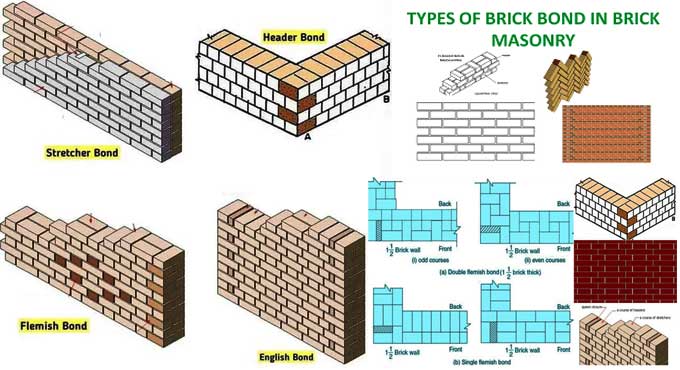
A Description of the Types of Brick Closers and Bonding

Building walls, pavements, and other elements using brick is a common function of brick in construction. The ingredients that are used in brick production include dried clay, sand, lime, and other ingredients. Walls and boundary walls are mostly constructed with it.
When laid flat, the Indian standard-size brick measures 19 cm x 9 cm x 9 cm. US bricks are typically modular bricks with a standard size of 194 x 92 x 57 mm. Furthermore, bricks in the UK are usually 215 mm x 102.5 mm x 65 mm in size.
Define Brick Masonry
It is called brick masonry when the bricks are laid in mortar in a systematic way to create a mass that acts as a cohesive unit and resists forces without disintegrating.
The bed of brick refers to the surface on which bricks are placed on both sides.
Brick Closer Types
Basic Closer
One long face of the brick remains intact when the brick is split along the length.
Queen Closer
An unbroken brick is called a queen closer when it is split in half along its length. An original brick is half the width of a queen closer, which is a broken brick part. It is also known as the queen's closer half.
Queen Closer Quarter
Whenever a queen closer is split into two halves, queen closer quarters are formed. A queen closer quarter is a brick piece that is one quarter of the height of a brick.
King Closer
It is called a king closer when one end of a brick is split so that one half of its width is offset from the other half, with the other end as wide as a full brick. Splitting out a triangular portion of the brick between one end's center and the other end's center yields it. The face of the header is half and the face of the stretcher is half.
Bevelled Closer
A chamfered or bevelled brick is a type of king closer in which the whole length of the brick maintains half width at one end and full width at the other.
Mitred Closer
A splayed or mitred brick's one end is split so the entire width can be provided by it. There may be a difference between 45 degrees and 60 degrees in the angle of splay. In this instance, one longer face of the mitered closer extends the full length of the brick while the other longer face extends only briefly.
Brick Bonding Types in Brick Masonry
Flemish Bonding
A header and stretcher are alternated in each course to form the arrangement of bricks. Throughout this bonding, each alternate course starts with the header. In order to prevent vertical joints from aligning in the same straight line, queen closers are placed next to join closers.
Compared to English bonds, Flemish bonds are more economical, but they require highly skilled labor.
Header Bonding
The headers in each course make up the bonding arrangements. Each alternative course begins with 3-quarter bat bricks to break up the vertical joints that follow the same straight line.
English Bonding
An English bonding brick arrangement consists of alternate headers and stretchers layered over each other. Over the header, a quarter brick is available for each stretcher over the header to break the alignment of vertical joints. All types of bonds provide higher strength than this type of bonding.
Stretcher Bonding
Every course of bonding is separated by a stretcher. It is necessary to break the vertical alignment joints in a straight line by using half Bat bricks. An underlying bond is provided when a half brick wall is necessary. A partition wall is constructed using this bonding when no load bearing wall is needed because it is weak.
To learn more, watch the following video tutorial.
Video Source: Anime_Edu - Civil Engineering Videos
Wrapping it Up
The shifting of large stones was a very difficult task for laborers in the ancient period when buildings were constructed with stones and lime mortar. For the purpose of building a building, different types of bonds are used to bind lightweight bricks and cement mortar.
Masonry made from bricks and mortar is called brick masonry. It is possible to use mud mortar for temporary shades and lime mortar for permanent buildings.


